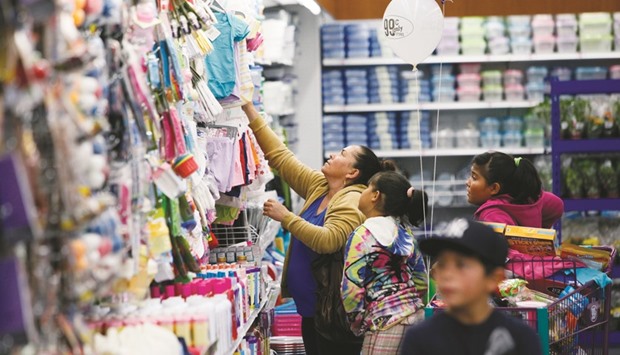US retail sales rebounded in September amid a surge in motor vehicle purchases and some pickup in discretionary spending, pointing to solid demand that reinforces expectations of an interest rate increase from the Federal Reserve in December.
Other data yesterday suggested a pickup in inflation, with producer prices rising broadly last month to record their biggest year-on-year increase since December 2014.
The reports were the latest indication that the economy regained momentum in the third quarter after a lacklustre first-half performance.
“The consumer is spending and cost pressures are slowly building.
The argument against a rate hike is getting weaker and weaker,” said Joel Naroff, chief economist at Naroff Economic Advisors in Holland, Pennsylvania.
The Commerce Department said retail sales increased 0.6% after declining 0.2% in August.
Sales were up 2.7% from a year ago.
Excluding automobiles, gasoline, building materials and food services, retail sales edged up 0.1% last month, reversing August’s 0.1% drop.
These so-called core retail sales correspond most closely with the consumer spending component of gross domestic product.
Though the small gain in core retail sales last month suggests a moderation in consumer spending from the second quarter’s robust 4.3% annualised rate, economists said they expected consumption grew at around a still solid 2.8% pace in the third quarter.
“Overall, the details of the report are more positive than what the modest print on core sales suggests,” said Brittany Baumann, an economist at TD Securities in Toronto. “Together with healthy levels of consumer sentiment and continued improvement in labour market conditions, today’s report is enough to keep a December Fed rate hike firmly on the table.”
Economists had forecast overall retail sales increasing 0.6% and core sales advancing 0.4% last month.
While a separate report showed consumer sentiment slipped in early October, the University of Michigan which sponsors the survey blamed the drop on “uncertainty” surrounding the November 8 presidential election.
Minutes of the Fed’s September 20-21 policy meeting published on Wednesday showed several officials believed it would be appropriate to increase interest rates “relatively soon” if the economy continued to gain strength.
The US central bank raised its benchmark overnight interest rate last December and has held it steady since, largely because of concerns over low inflation.
But inflation appears to be rising steadily.
In a third report, the Labor Department said its producer price index for final demand increased 0.3% last month after being unchanged in August.
In the 12 months through September, the PPI jumped 0.7%, the biggest increase since December 2014.
The PPI was flat in the 12 months through August.
A 0.7% increase in the cost of goods, including energy, accounted for more than three quarters of the rise in final demand prices.
Producer prices are rising as some of the drag from the dollar’s past surge starts to ease.
The dollar rally appears to have peaked early this year and oil prices having pushed off multi-decade lows, which economists expect could allow inflation to gradually rise toward the Fed’s 2% target.
The dollar was trading higher against a basket of currencies, while US Treasuries fell.
The mixed retail sales report added to upbeat data on the labour market and manufacturing and services sector surveys that have suggested economic growth picked up in the third quarter.
The Atlanta Fed is currently forecasting the economy growing at a 2.1% annualised rate in the third quarter after a 1.4% expansion pace in the second quarter.
Auto sales rose 1.1% last month after slipping 0.3% in August.
Retail sales were also boosted by receipts at service stations, which jumped 2.4% as gasoline prices increased.
Sales at online retailers rose 0.3%.
Despite core retail sales rising modestly last month, households are boosting discretionary spending.
Sales at restaurants and bars advanced 0.8%, the largest gain since February, and receipts at sporting goods and hobby stores surged 1.4%.
There were also strong increases in sales at furniture and building material stores.
But sales at electronics and appliance outlets fell 0.9% and receipts at clothing stores were flat.

Customers shop for baby clothing at a 99 Cents Only Store in San Bernardino, California. The US Commerce Department yesterday said retail sales increased 0.6% after declining 0.2% in August.


